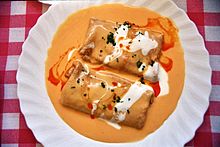Palatschinke



Palatschinke (plural Palatschinken) is the Austrian and Bavarian German name of the thin, crêpe-like variety of pancake common in Central Europe.
The pancake
Central European pancakes are thin pancakes. Unlike the thick American pancake, a Palatschinke is filled with different types of fillings and eaten for lunch or dinner. Palatschinke is thin and comparable to the French crêpe.
Palatschinken are traditionally rolled with apricot jam or strawberry jam,[1] rolled up and sprinkled with confectioner's sugar. A variety of different fruit sauces, (like apple sauce) or thick fruit jams called lekvar, (plum, prune, raspberry, cherry or sour cherry jam), lemon juice and sugar, chocolate sauce, hazelnut-chocolate cream, almonds, dried or fresh fruits, sweet cottage or quark cheese and raisins, cocoa powder, poppy seed, or any combination thereof, may also be used. Rakott palacsinta[2] are layered pancakes with sweet cottage cheese and raisins, jam and walnut layers between the pancakes, baked in the oven.
A well known Hungarian version of palatschinke is the Gundel pancake (Gundel palacsinta), made with ground walnuts, raisin, candied orange peel, cinnamon and rum filling, served flambéed in dark chocolate sauce made with egg yolks, heavy cream and cocoa.
Palatschinke may also be eaten unsweetened, filled with cheeses, meat, mushroom or vegetable stews, topped with sour cream, or cut into thin strips and boiled in broth, called Flädle in German. Flädle is used for example in Frittaten soup, - pancake strips in usually clear soup.
Etymology
The name of the dish has followed a track of borrowing across several languages of central and south-eastern Europe. The Austrian-German term Palatschinke is borrowed from Czech palačinka, that in turn from Hungarian palacsinta, and that in turn from Romanian plăcintă (a cake, a pie), where it ultimately derives from Latin Placenta (a flat cake), a word of Greek origin.[3] Palačinka is also the name in most Slavic languages (Ukrainian, Czech, Slovak - palacinka, Slovenian, Bosnian, Bulgarian, Macedonian, Croatian, Serbian). In Polish, the equivalent is called a naleśnik, in Romanian clătită.
See also
References
- ^ June Meyers Authentic Hungarian Heirloom Recipes Cookbook
- ^ Gundel, Karoly (1992 the). Gundel's Hungarian cookbook. Budapest: Corvina. ISBN 963-13-3600-X. OCLC 32227400.
{{cite book}}: Check date values in:|year=(help)page 124 - ^ Kluge Etymologisches Wörterbuch der deutschen Sprache, 2003, Walter De Gruyter, ISBN 3110174723 p. 675
